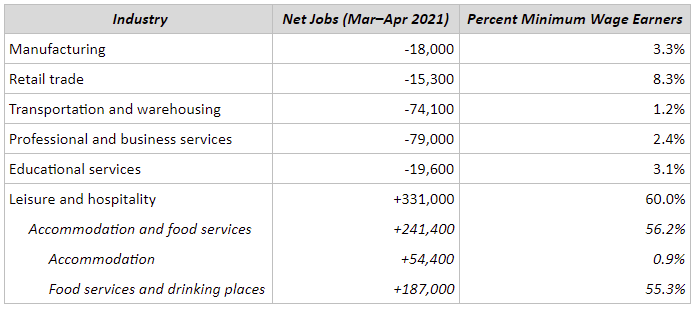Amidst a disappointing April jobs report, President Biden remarked that raising wages would help businesses solve a labor shortage. Union-backed pro-wage hike advocates like the Restaurant Opportunities Center have also deemed the current labor situation a “wage shortage, not a labor shortage.”
However, data regarding the leisure and hospitality industry, which employs a majority of minimum-wage earners, shows it is well ahead of other industries in terms of driving job gains and filling labor gaps.
While the net increase in jobs between March and April was lower than analysts expected, the Bureau of Labor Statistics found “notable” gains in the leisure and hospitality sectors (driven primarily by increases in restaurants and bars) were offset by losses in other industries. The major contrast here is that leisure and hospitality employs 60 percent of all minimum wage earners, while industries driving job losses in April tended to be industries with relatively very few minimum wage workers.

Recent 2021 data also shows that the Accommodation and Food Services industry has also been adept at filling job openings, both pre- and post-pandemic, compared to the average of all private industries. Bureau of Labor Statistics Job Openings and Labor Turnover Survey (JOLTS) data show the Accommodations and Food Services industry has had a higher success rate at filling open positions in 2020 and 2021 than even before the pandemic, and is also more successful than the ratio for all US nonfarm jobs.
- The industry had a monthly average of 47 percent more hires than openings in 2020, and 29 percent more hires than openings in January and February 2021.
- Compare this with the average for all nonfarm businesses, which had 3% fewer monthly hires than openings on average in 2020, and even fewer in 2021: 23% fewer hires than openings through January and February.
Companies should be able to examine their own margins and make their own wage-setting decisions, especially during this critical period of recovery. The data shows that industries like those in the leisure and hospitality sector are leading the pack in terms of job gains. This falls in line with the demonstrated impacts minimum wage job opportunities have for workers.
- Minimum wage opportunities are critical entry-level stepping stones for many workers, providing experience for those new to the labor force, including teenagers.
- Analysis of Census Bureau data shows that most minimum wage workers receive a raise within 1 to 12 months after starting the job.
- Workers who earn a base wage plus tips, predominantly in the restaurant industry, often earn far more than the regular minimum wage with their tip income, making restaurant and bar service a substantial livelihood.
Some policymakers and other experts say the expanded pandemic-related unemployment benefits are contributing to lags in hiring. In an op-ed in the Washington Post, American Enterprise Institute fellow Marc A. Thiessen examined the following reality for many business owners:
“Carl Howard, chief executive of the Fazoli’s restaurant chain, does the math. ‘In Ohio you can make $452 a week in unemployment,’ he says. ‘The federal government is going to top that with $300. That’s $752 [a week]. If I pay $15 an hour, that’s $600.’ In other words, even if he matches what Democrats say should be the federal minimum wage, he can’t compete with the unemployment office.’”
Using the current labor situation to push government-mandated wage floors will only harm minimum wage employees. The nonpartisan Congressional Budget Office projected that the Raise the Wage Act’s $15 minimum wage would cost up to 2.7 million jobs across the country. Economists project nearly half of job losses to fall in the hospitality industry. Yet, the industries currently experiencing losses have a minimal percent of employees that would be directly impacted by government wage mandates, limiting the potential effect of a wage hike on raising employment.
Job losses would fall heavily on the industries driving much of the current job gains, while other industries would see no positive change.

